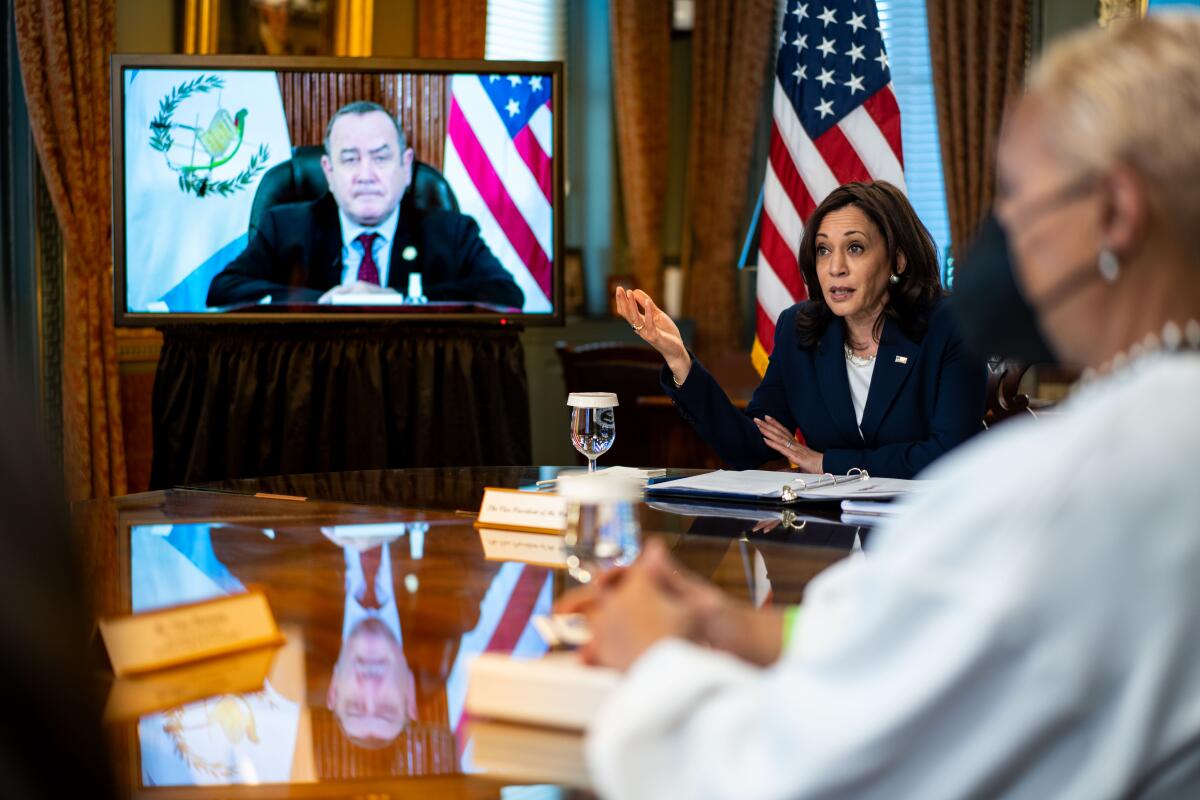Why is Vice President Kamala Harris going to Guatemala and Mexico?

- Share via
WASHINGTON — When Vice President Kamala Harris leaves Sunday night for her first official trip out of the country, she won’t be going far or for long. Guatemala and Mexico are closer to Washington than her home in California, and she’ll spend just a day in each country.
But the stakes are big, for Harris and the country.
The trip will be her most high-profile act yet on the first international assignment President Biden gave her, in March, to tackle the root causes of migration from the Central American countries in what is known as the Northern Triangle — Honduras, El Salvador and Guatemala.
“This is a historic moment,” said Sergio Gonzalez, who advised Harris on immigration issues when she was a senator from California. “This is going to be the first time that other nations receive a vice president of the United States who is a woman of color.”
Mexico is crucial to Harris’ portfolio as the transit route for migrants heading to the U.S. Martha Bárcena, former Mexican ambassador to Washington, said the vice president will help define U.S. relations with its southern neighbor.
“It will be the first impression of a high-level official of the new U.S. administration to Mexico,” Bárcena said Friday in a discussion held by the Atlantic Council, a Washington-based think tank.
Soon after Harris returns Tuesday, Biden will take his maiden overseas trip as president, for summits with allies in Britain and Belgium, followed by his first meeting as president with Russian leader Vladimir Putin in Switzerland.
Here is a primer on the issues Harris will be confronting in her diplomatic debut.
What are the root causes of migration?
Harris has said repeatedly that people don’t want to leave their homes unless they feel they have no choice. Increasingly large numbers of families and children without their parents have been driven to make dangerous and expensive journeys north because of poverty, crime, drug cartels, destructive hurricanes, the COVID-19 pandemic and loss of faith in their governments, she argues.
Ana Maria Mendez, who is based in Guatemala City as Central America director for the nonprofit Oxfam, agreed and said families that have less than $100 in savings borrow from loan sharks to pay $10,000 to smugglers because they feel they have no alternative. For those who remain behind, seeing off their relatives is “almost like burial,” she said, given migrants’ risks of rape, abuse and death, and the reality that they may never return.
“It’s a desperate march toward the north, and it’s unstoppable because people are literally suffering of hunger, severe malnutrition,” Mendez said.
Many Republicans place the blame elsewhere. They say lax border security and the belief that Biden is softer on illegal immigration than former President Trump have spurred migrants north.
And what are the roots of these root causes?
Chronic poverty and violence have been years in the making, partly due to past decades’ proxy wars in the region between the U.S. and the former Soviet Union. Drug trafficking dates to that time. More recently, Trump embraced regional leaders despite their opposition to anti-corruption programs.
How is Harris proposing to address poverty and corruption?
Harris has emphasized that none of this will be fixed quickly. She told reporters Wednesday that she wants to discuss what the U.S. can do to “support the folks who need help in terms of hunger, the economic development piece, the extreme weather.”
The administration has begun several actions, including recruiting businesses such as Nespresso, Microsoft and MasterCard to start investment programs with federal subsidies, and ramping up aid that Trump cut. Harris in April announced an additional $310million for the region. Additionally, the U.S. vaccine-sharing program gives priority to Northern Triangle countries as part of a tranche of 6 million doses for South and Central America.
To reduce corruption, the administration is channeling as much aid as possible through third-party groups. Yet most nongovernmental groups lack the capacity to handle billions of dollars in assistance.
Harris has said that in meeting with leaders in the region, she’ll have “very frank and honest discussions about the need to address corruption, to address crime and violence, and in particular against some of the most vulnerable populations.”
The administration also wants to send additional border enforcement officers to the region and has begun building “migrant resource centers” — the first is set to open in Guatemala — to allow people to apply to migrate or seek asylum from their home countries without making the perilous trek north.
How will Harris fill her time in these two days?
She will have face-to-face meetings with Guatemalan President Alejandro Giammattei and Mexican President Andrés Manuel López Obrador and will visit with U.S. embassy staffs as well as local entrepreneurs and labor representatives.
Stephen Johnson, who advised the George W. Bush administration on the region, said corruption will probably be mentioned obliquely in public statements when Harris meets with Giammattei, but “in the private conversations, I think it will be a bit more pointed.”
Can she get out of the conference rooms to meet with “regular people”?
It’s difficult to meet many average citizens on these trips, given the time limits and protocol and security requirements. But it’s possible Harris will make one or two unannounced stops in places where she can meet la gente for photo ops and build some goodwill with local populations.
Why is she visiting just one of the three Northern Triangle countries?
Good question, and it underscores her challenge.
Harris has avoided direct talks with the increasingly authoritarian Salvadoran President Nayib Bukele and Honduran President Juan Orlando Hernández, whose brother was recently sentenced to life in prison by a federal judge in Manhattan for drug trafficking in a case that implicated the Honduran president.
Lower-level administration officials have met with their counterparts in El Salvador and Honduras. But the leaders are still off-limits.
That’s not to sanctify Guatemala and Mexico. López Obrador regularly attacks the free press and independent watchdogs, and Guatemala in 2019 abolished an internationally backed agency that fought corruption.
She’s going to Mexico, so she’ll see the border, right?
No. Harris has avoided the U.S.-Mexico border, and her staff has pointed out that her task does not include fixing conditions there or in the overburdened immigration system. Republicans have been critical, seeing immigration as one of Democrats’ political liabilities. Some Democrats and experts on the region also say Harris ought to consider going.
Noah Gottschalk, Oxfam America’s head of global policy, said Harris’ work on the underlying causes of migration underscores the White House’s “deeply hypocritical” border policy. While the administration recognizes the bleak and dangerous conditions in the Northern Triangle, he said, it has been sending back people who flee, citing an obscure 1944 public-health law known as Title 42.
Why is she going to Mexico, if not to the border?
The administration wants more help from Mexico in turning away Central Americans before they reach the U.S. But that’s controversial for López Obrador, a populist who doesn’t want to be seen as America’s enforcer. Also, he likely will be preoccupied with the results of his country’s provincial and congressional election Sunday, a day before Harris arrives.
What are the political pros and cons for Harris?
Anyone who has read this far knows she’s got a tough assignment.
Harris has avoided outlining what success means. Biden had a similar job when he was vice president under President Obama, and, well, here we are.
Still, the effort is giving Harris some prominence in the foreign policy arena — which is important for anyone with aspirations to the presidency.
More to Read
Get the L.A. Times Politics newsletter
Deeply reported insights into legislation, politics and policy from Sacramento, Washington and beyond. In your inbox twice per week.
You may occasionally receive promotional content from the Los Angeles Times.











